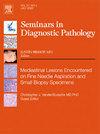Keratin-positive giant cell-rich tumor review
IF 3.5
3区 医学
Q2 MEDICAL LABORATORY TECHNOLOGY
引用次数: 0
Abstract
Keratin-positive giant cell-rich tumor is a recently described mesenchymal neoplasm, which occurs predominantly in young women and often arises in the subcutis or bone. Histologically, tumors vary from giant cell tumor-like to xanthogranulomatous, or a mixture of both patterns. Tumors with predominantly xanthogranulomatous infiltrate and scattered mononuclear cells with bright eosinophilic cytoplasm were originally described as xanthogranulomatous epithelial tumor, a lesion which was subsequently found to be on a morphologic spectrum with keratin-positive giant cell-rich tumor. Most cases express keratin, characteristically with demonstration of dendritic-like cytoplasmic projections, and harbor HMGA2::NCOR2 fusions. High level expression of CSF1, in the absence of CSF1 gene alterations, is also frequently observed. Data on the clinical behavior of keratin-positive giant cell-rich tumor is limited. The course is often indolent, however rare cases are aggressive.
角蛋白阳性富巨细胞肿瘤综述
角蛋白阳性巨细胞瘤是最近发现的一种间质肿瘤,主要发生于年轻女性,常发生于皮下或骨。组织学上,肿瘤从巨细胞瘤样到黄色肉芽肿,或两种类型的混合。以黄色肉芽肿性浸润和分散的单核细胞为主,细胞质嗜酸性明亮的肿瘤最初被描述为黄色肉芽肿性上皮肿瘤,这种病变随后被发现在形态学谱上与富含角蛋白阳性巨细胞的肿瘤一致。大多数病例表达角蛋白,以树突样细胞质突出为特征,并伴有HMGA2::NCOR2融合。在没有CSF1基因改变的情况下,也经常观察到CSF1的高水平表达。有关角蛋白阳性巨细胞富肿瘤临床行为的资料有限。病程通常是缓慢的,但罕见的病例是侵袭性的。
本文章由计算机程序翻译,如有差异,请以英文原文为准。
求助全文
约1分钟内获得全文
求助全文
来源期刊
CiteScore
4.80
自引率
0.00%
发文量
69
审稿时长
71 days
期刊介绍:
Each issue of Seminars in Diagnostic Pathology offers current, authoritative reviews of topics in diagnostic anatomic pathology. The Seminars is of interest to pathologists, clinical investigators and physicians in practice.

 求助内容:
求助内容: 应助结果提醒方式:
应助结果提醒方式:


